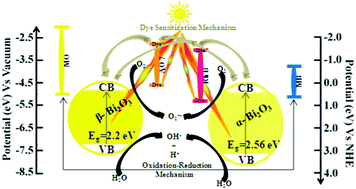Phase-controlled synthesis of bismuth oxide polymorphs for photocatalytic applications†
Abstract
In this study, bismuth oxide polymorphs (α and β phases) were synthesized using a post-calcination method using Bi2O2CO3 nanoflakes as an intermediate. These samples were characterized by various spectroscopic techniques such as powder X-ray diffraction, Fourier transform infrared spectroscopy, Raman spectroscopy, UV-visible absorption, photoluminescence studies and microscopic analysis (scanning and transmission electron microscopy). The mechanism of the formation of β-Bi2O3 nanoparticles and the α-Bi2O3 coral-like morphology has been proposed. Furthermore, the photocatalytic performance of the bismuth oxide polymorphs was investigated via the degradation of organic dyes (rhodamine B, methylene blue, acid orange 7 and methyl orange) under simulated solar illumination. The results show that the β-Bi2O3 nanoparticles possess superior photocatalytic activity compared to the α-Bi2O3 coral-like morphology for the degradation of these dyes due to a higher photon adsorption (band gap of 2.2 eV for β-Bi2O3 and 2.56 eV for α-Bi2O3). However, the photocatalytic activity of these bismuth oxide polymorphs for the degradation of organic dyes followed the order of Rh B > AO 7 > MB > MO under identical experimental conditions. A plausible mechanism has been proposed for the photocatalytic activity.



 Please wait while we load your content...
Please wait while we load your content...